See also
- Sillon industriel, the industrial valley of Belgium, the western part of which lies in the Pays Noir
- Borinage
- Black Country, a similar early industrial region in the English Midlands
The Pays Noir (French for 'black country') refers to a region of Belgium, centered on Charleroi in the province of Hainaut in Wallonia so named for the geological presence of coal. In the 19th century the region rapidly industrialised first with coal mines, then with related industries such as steel manufacture and glass production.
The region, centred on Charleroi, [1] also known as the Pays de Charleroi includes the communes of Aiseau-Presles, Charleroi, Châtelet, Courcelles, Farciennes, Fleurus, Fontaine-l'Évêque, Gerpinnes, Les Bons Villers and Pont-à-Celles. [2]
In the west, the Pays Noir borders the Centre-region around the town of La Louvière. Geologically, the region - as well as the other coal bearing areas in Belgium - lies on the northern edge of the Rhenish Massif. [3]
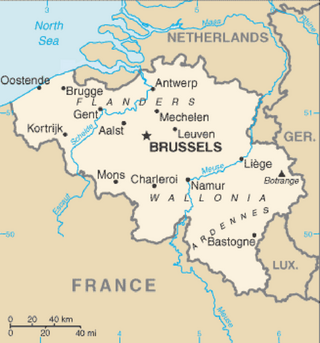
Belgium is a federal state located in Western Europe, bordering the North Sea. Belgium shares borders with France (620 km), Germany (133 km), Luxembourg (130 km) and the Netherlands (478 km). Belgium is divided into three regions: Flanders, Wallonia and Brussels.
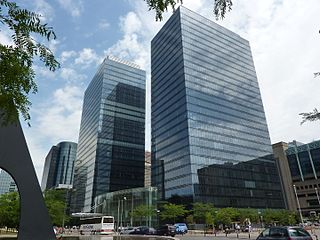
The economy of Belgium is a highly developed, high-income, mixed economy.

Wallonia, officially the Walloon Region, is one of the three regions of Belgium—along with Flanders and Brussels. Covering the southern portion of the country, Wallonia is primarily French-speaking. It accounts for 55% of Belgium's territory, but only a third of its population. The Walloon Region and the French Community of Belgium, which is the political entity responsible for matters related mainly to culture and education, are independent concepts, because the French Community of Belgium encompasses both Wallonia and the bilingual Brussels-Capital Region but not the German-speaking Community of Belgium.
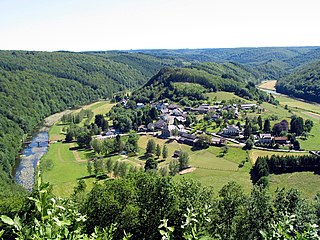
The Ardennes, also known as the Ardennes Forest or Forest of Ardennes, is a region of extensive forests, rough terrain, rolling hills and ridges primarily in Belgium and Luxembourg, extending into Germany and France.

Charleroi is a city and a municipality of Wallonia, located in the province of Hainaut, Belgium. The city is situated in the valley of the Sambre, in the south-west of Belgium, not far from the border with France. By 1 January 2008, the total population of Charleroi was 201,593. The metropolitan area, including the outer commuter zone, covers an area of 1,462 square kilometres (564 sq mi) with a total population of 522,522 by 1 January 2008, ranking it as the 5th most populous in Belgium after Brussels, Antwerp, Liège, and Ghent. The inhabitants are called Carolorégiens or simply Carolos.

La Louvière is a city and municipality of Wallonia located in the province of Hainaut, Belgium.
Cockerill-Sambre was a group of Belgian steel manufacturers headquartered in Seraing, on the river Meuse, and in Charleroi, on the river Sambre. The Cockerill-Sambre group was formed in 1981 by the merger of two Belgian steel groups – SA Cockerill-Ougrée based at Seraing in the province of Liège, and Hainaut-Sambre based at Charleroi in the province of Hainaut – both being the result of post-World War II consolidations of the Belgian steel industry.
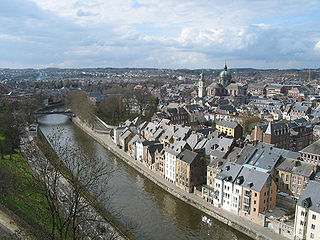
The Sambre is a river in northern France and in Wallonia, Belgium. It is a left-bank tributary of the Meuse, which it joins in the Wallonian capital Namur.

The Borinage is an area in the Walloon province of Hainaut in Belgium. The name derives from the coal mines of the region, bores, meaning mineshafts. In French, the inhabitants of the Borinage are called Borains.
Coal mining regions are significant resource extraction industries in many parts of the world. They provide a large amount of the fossil fuel energy in the world economy.

The Sillon industriel is the former industrial backbone of Belgium. It runs across the region of Wallonia, passing from Dour, the region of Borinage, in the west, to Verviers in the east, passing along the way through Mons, La Louvière (Centre-region), Charleroi, Namur, Huy, and Liège. It follows a continuous stretch of valleys of the rivers Haine, Sambre, Meuse and Vesdre, and has an area of roughly 1000 km2.
The history of Wallonia, from prehistoric times to the present day, is that of a territory which, since 1970, has approximately coincided with the territory of Wallonia, a federated component of Belgium, which also includes the smaller German-speaking Community of Belgium. Wallonia is the name colloquially given to the Walloon Region. The French word Wallonie comes from the term Wallon, itself coming from Walh. Walh is a very old Germanic word used to refer to a speaker of Celtic or Latin.

John Cockerill & Cie. was a Belgian iron, steel, and manufacturing company based at Seraing in Liège Province. It was founded in 1825 by English-born industrialist John Cockerill.
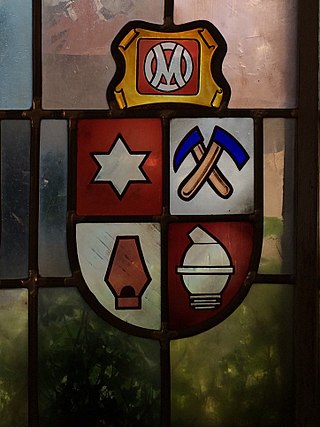
The Belgian iron and steel producing company Ougrée-Marihaye was formed in 1835 by the merger of the iron and steel works in Ougrée in Liège Province, and the coal mines of Marihaye. The company merged with the Société anonyme John Cockerill in 1955 to form Cockerill-Ougrée.

ArcelorMittal Ghent is a Belgian steelworks situated in Ghent near Zelzate, Flanders. It was founded in 1962 by ARBED as Sidmar; the first maritime steel producer in Belgium.

Espérance-Longdoz was a coal mining and steel production company located in the Liège region of Belgium.

The Centre or the Région du Centre is a region within the province of Hainaut in Wallonia, Belgium. It is part of the Sillon industriel or industrial centre of Belgium.

The Compagnie des mines d'Anzin was a large French mining company in the coal basin of Nord-Pas-de-Calais in northern France. It was established in 1756 and operated for almost 200 years.

Mining in France is based solely on the nature of the material, whether extracted from the surface or underground. These include fuels, metals and a few other minerals.
Clémence Michel was a Belgian artist. She worked in Brussels, especially in Schaerbeek, where she had a studio at rue des Ailes no. 58.